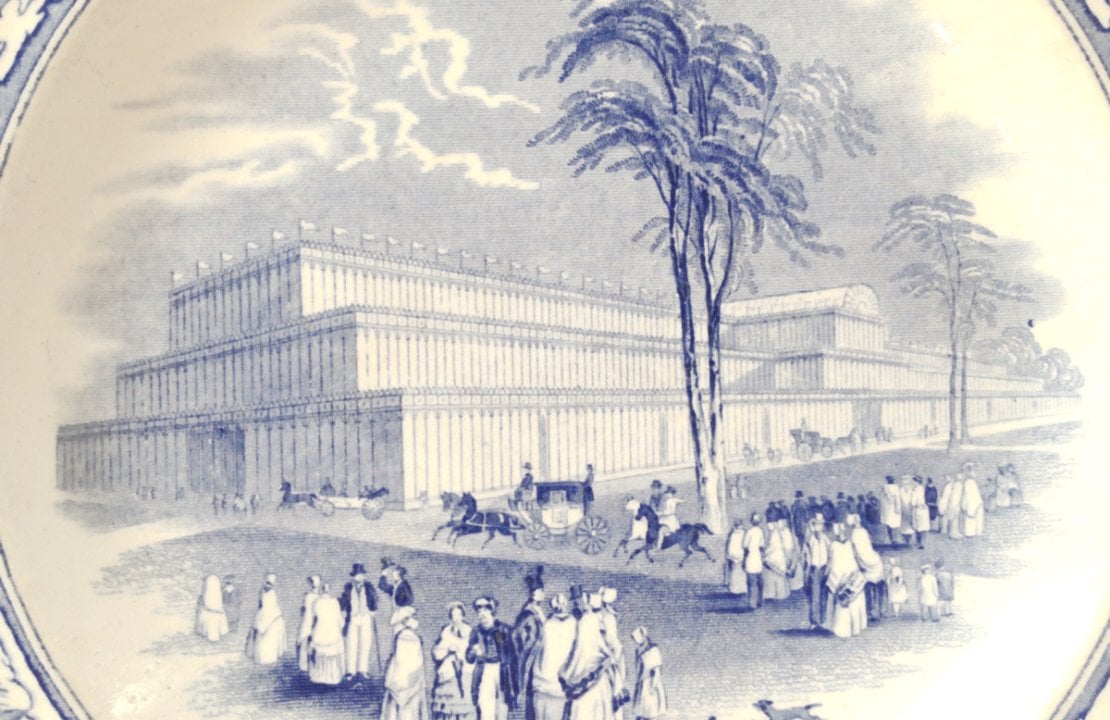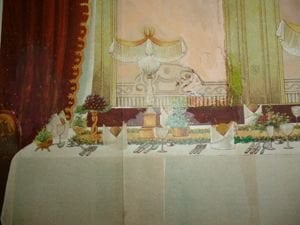What cutlery was used at a Victorian dinner party?
All these courses and decorations made formal dinner tables in the Victorian era very cluttered, but each piece of silver, china and glassware had its appointed place. All stemware required throughout the meal would be placed on the table beforehand; a top row would consist of, from left to right; a water glass, a glass for burgundy, a glass for another wine type, then a champagne glass. The bottom row would have a green glass for sauterne on the far left, then a sherry glass and a red glass for Rhine wine. China was usually white or cream with a line of colour or gilding near the rim, or the crest or monogram, or both, of the host in a medallion or circle at the side.
As many as eight knives and eight forks could be expected to be placed on the table; a fish fork, a dinner fork and even an ice cream fork. Individual knives were used for butter, cheese, game, roast and fruit, each accompanied by its own knife rest.
The illustration of a dining table for 12 in my edition of Mrs Beeton’s Household Management show serviettes folded to look like crowns with a bread roll placed in the centre, but these are a fairly pedestrian shape. More elaborate folding of napkins resulted in complicated shapes from the natural world, such as that of a swan. Elaborate stands of fruit and shell-shaped containers holding foliage decorate the table setting. Dishes of celery, olives or radishes filled the remaining space on a table as well as other items such as berry bowls, butter dishes, cruets, salt cellars, spoon holders, ice water sets, epergnes (branched ornamental centrepieces), honey dishes, decanters and cake stands. Compotiers holding an assortment of little cakes frequently stood next to the stands of fruit. Exotic fruits and flowers were favoured as decoration, as these could transform a plain table from furniture into a garden paradise and transport diners from cold, rainy weather to warmer, brighter climes. Mrs Beeton, in her recommendations for decorating a dinner table in November, says:
“In this, generally the most gloomy month of the year, we want something bright for our tables in the way of flowers and foliage. If hot-house flowers are obtainable, it is an easy task to make a suitable decoration…Chrysanthemums are the most to be depended on of all… An old-gold centre of silk puckered in folds, or plain plush one looks well with the soft tints of the brown and gold flowers, and one of chestnut colour goes well with the white ones. Some delicate palms and ferns may find a place on dinner tables now.”
Victorian dinner parties were opportunities to show one’s affluence and style and sometimes a hostess would choose a theme. Agnes Rackham, the wealthy wife in Michel Faber’s wonderfully descriptive novel The Crimson Petal and the White, set in 1874, chose “Black and White” for her dinner party during the Season of that year. Her table and chairs were black, her tablecloth white with black candleholders, white crockery, cutlery painted white, white napkins and black finger bowls. Even the food was black and white – there was sole, with blackened skin still on, black mushrooms and blackened baked pumpkin in white sauce. No red wine was served, only white. Ices, with licorice sauce were served as dessert. Her guests raved about the novelty and audacity of the event!
Whats a typical Victorian dinner party menu?
Dinner itself, consisting of multiple courses, was a protracted affair. Plenty of time was needed between each course to permit each guest to rest and digest before the next course. Mrs Beeton’s November Dinner for Twelve Persons menu is made up of:
Oysters
Clear Mock Turtle Soup
Turbot, Horseradish Sauce, Smelts (small fish, akin to salmon)
Lark Pie, Croquette of Chicken
Saddle of Mutton, Potatoes, Brussels Sprouts
Pheasants
Curacao Souffle
Marbled Jelly
Mrs Beeton recommended a lighter menu be served in August, such as:
Appetisers
Crayfish Soup
Salmon, Dutch Sauce
Chaudfroid of Chicken, Minced Veal with Bechamel Sauce
Haunch of Mutton, Potatoes, French Beans
Black Game
Compote of Fruit
Raspberry Tart
Vanilla Cream
Cheese Straws
The Victorian dining room also did not escape heavy decoration: The Social Mirror, a magazine publication of the time, said “it should be furnished with a view to convenience, richness and comfort.” Walls were often rendered in bronze, maroon or black. If one was inclined towards walls of Pompeiian red or deep olive with a dado or frieze, these should be in old gold, olive or moss green, according to The Social Mirror, as could be the wainscoting on the walls and ceiling. Pompeiian red or soft olive were recommended for draperies and dark woods “should be used.” A buffet usually stood in a corner of the room for the display of decorated china or ceramics and a sideboard “should be of high, massive style with shelves and racks for glassware and china.” Other suggested decorations were “a cage of stuffed birds, a few large pots of tropical plants and a fernery.” Last, but not least: “A folding screen should not be forgotten.” The dining table illustration from Mrs Beeton’s seminal book shows the recommended Pompeiian red drapes with a wall in muted salmon and an olive green pillar. Pompeiian red features again on the lower part of the wall and a decorative dado abuts it.
If you wish to replicate elements of Victoriana in your own Victorian dining room, lighting would be a good investment, particularly crystal-shaded wall lights with brass fittings. Table lamps too at different levels to the wall lights, would help bathe the room in a soft warm light. A chandelier hanging from the ceiling however, would be the piece de resistance, opulence with which it is hard to compete. Palm trees in jardinieres placed on small tables along with ornate picture frames would complete the Victorian effect without cluttering the room significantly. One wants to enjoy dinner in the dining room, not spend excessive amounts of time dusting and cleaning it and, as Mrs Beeton expertly advises, sufficient time must be taken for dinner preparation which at all times must be thorough and detailed!
Copyright © Leigh Denton, 2013
Leigh is an Australian lawyer and the granddaughter of a Victorian era downstairs cook. She writes of the period, and its recipes, at downstairscook.blogspot.com



Be the first to add a comment...